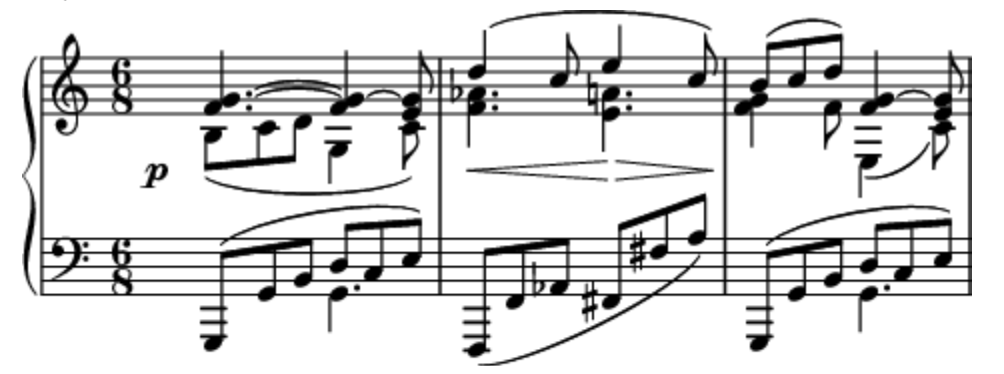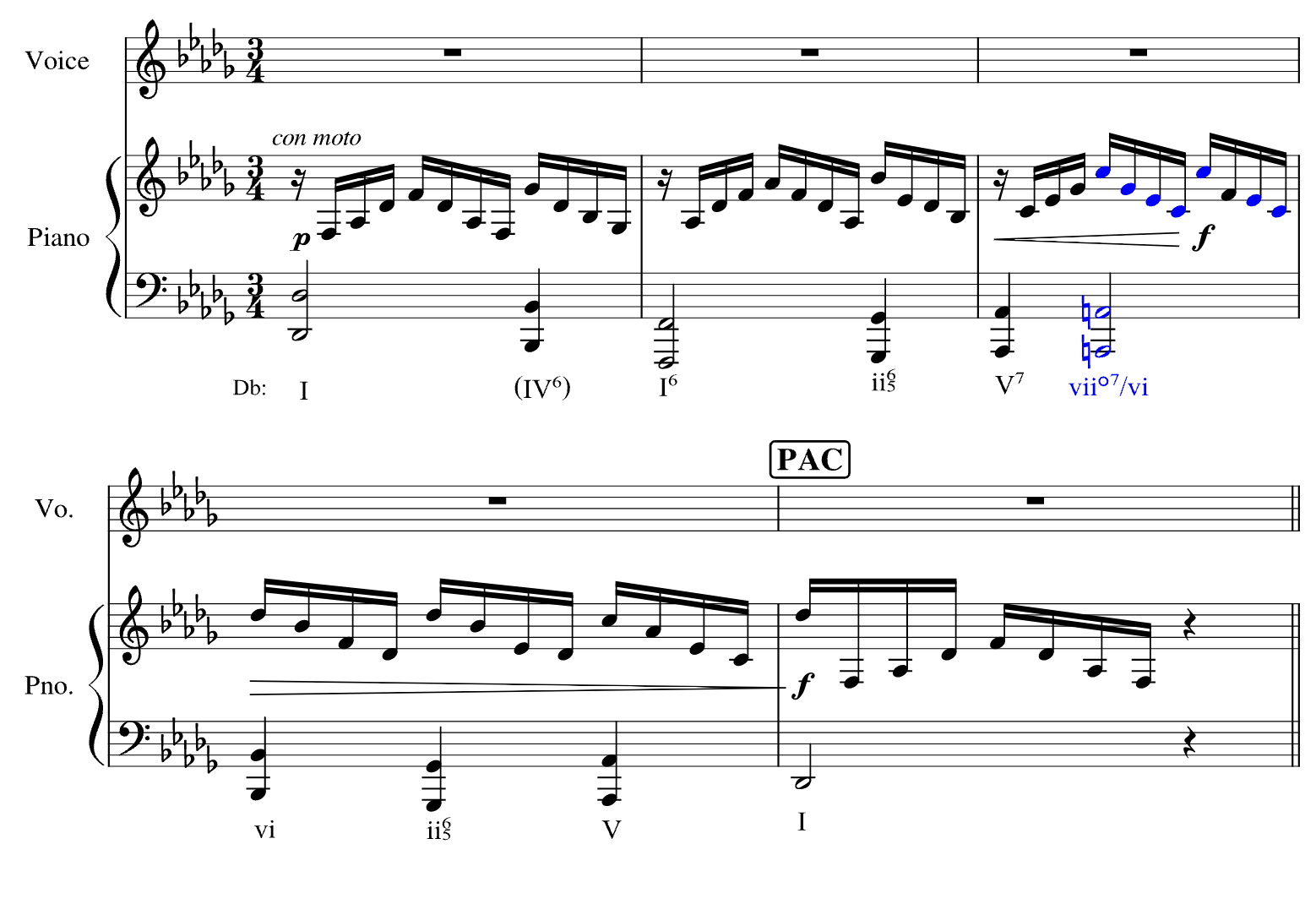7.4 Part Writing of Secondary Leading Tone Chords
6 min read•june 18, 2024
Sumi Vora
AP Music Theory 🎶
72 resourcesSee Units
In the last unit, we went through how to identify secondary leading tone chords in tonicization. Here, we will review what secondary leading tone chords are and we will practice part writing them.
Secondary Leading Tone Chords
Remember from previous lessons that the vii० has a very similar function to the V chord: they both serve a dominant function that creates a cadence when resolved to the I chord. So, just like V chords, it is useful to use a secondary leading tone during tonicization. These chords usually appear as seventh chords: vii०⁷ and viiø⁷. Note that in a major key, you can use both vii०⁷ and viiø⁷, but in minor keys, you should only use vii०⁷. Usually, fully diminished seventh chords are more common.
Example: Write vii०/IV, vii०⁷/IV, and viiø⁷/IV in B major.
In B major, the root of the IV chord is E, so our new tonic is E. That means that our new leading tone is D#. So, vii०/IV is D#-F#-A♮, vii०⁷/IV is D#-F#-A♮-C♮, and viiø⁷/IV is D#-F#-A♮-C#.

Identifying Secondary Leading Tone Chords
Identifying secondary leading tone chords is a similar process as identifying secondary dominant chords. Start by looking for accidentals. If you see any accidentals, you should consider that you're looking at a secondary dominant.
Second, is this chord a diminished or half-diminished chord? Here's a little secret: College Board only tests on secondary dominants and secondary leading tone chords. V chords are (almost) always major, so if you're looking at a diminished/half-diminished chord with accidentals, then you're looking at a secondary leading-tone chord.
Let's look at another example. Try to analyze the chords in Brahms' Intermezzo, op 119 no. 3 in C major

Start by looking at measure 1 of the excerpt. On beat 1, the bass clef has a broken G major triad, and the treble clef has an F. (C is a passing tone) So, beat 1 is a V⁷ chord. On beat 2, there is a I⁶₄ chord, which is a passing 6-4 chord.
In measure 2, we have something interesting. On beat 1, we have a ii०⁶₅ chord (F-Ab-D-C), and on beat 2, we have F#-A-C-E, which is a diminished 7th chord. Since there are accidentals, we know that we might be dealing with a secondary leading-tone chord. F# is the leading tone for G, which is V of C, so we can write the chord in beat two as vii०⁷/V.
Why didn't we analyze beat one as a secondary leading tone? The notes on beat one are F-Ab-D-C, which means that the secondary leading tone would be in an inversion: we would write it as a 6-5 chord. And, since D is the leading tone of E, we could write it as a vii०⁶₅/iii. However, there are two problems with this. First, we usually don't see secondary leading tone chords in inversions because it erases the dominant function of the chord.
Second, musical context is important. If this were a tonicization, we would expect it to resolve to a iii triad. However, we "change key" again in beat 2 of the measure. That means that the chord doesn't serve a function as a chord in a secondary key, so we wouldn't analyze it as such.
Finally, in measure 3, we see another V⁷ chord, which makes sense musically because a vii०⁷/V is resolving to a V⁷. The last beat is another passing 6-4 chord.
Part Writing Secondary Leading Tone Chords
With secondary leading-tone chords, it's important to follow all voice-leading rules that you have learned in previous chapters. Keep in mind that, in tonicization, you'll have a different temporary leading tone, chordal seventh, and tonic. So, if we are in C major, the chordal seventh won't necessarily be F—it will be the 4th scale degree in whatever our temporary key is.
There are a few extra considerations to keep in mind when part-writing with secondary leading tone chords. First, you can't have a half-diminished 7th chord in minor because, in a minor key, we want to raise the leading tone to emphasize the dominant function of the vii°. Second, in minor keys, we don't build vii°/III or viiø⁷/III because these sound the same as ii° and iiø⁷. We also don't have viiø⁷/V, because then, we would have to both raise and not raise the leading tone in the same chord, which doesn't work.
Just like how root position viio7 chords are generally not considered acceptable in 18th century voice leading, secondary viio7 chords in root position should also be avoided if possible. Also, keep in mind that when you’re adding accidentals, we have a half diminished vii7 chord in Major, but we have a fully diminished viio chord in minor, since the interval between the fifth and the seventh of a vii7 chord in Major is a Major 3rd (e.g. the interval between F and A when writing a vii7 chord in C Major), but the interval between the fifth and the seventh of a vii7 chord in minor is a minor 3rd (e.g. the interval between F and Ab when writing a vii7 chord in C minor).
Remember that the leading tone should always be raised when writing these secondary leading tone chords. The whole point of using a secondary leading tone chord is to build tendency tones that resolve to the temporary tonic, so it would not be considered to have VII or VII7 chords in a secondary leading tone chord.
Tonicizing Deceptive Motion
Often, we might have a deceptive cadence, but there will be a tonicization of the deceptive cadence in order to “resolve” the deception. For example, we might move from a V to a vii/vi to a vi chord in Major. Why is this so common?
A vii/vi chord just has the root of the V chord, which means that the motion from the V chord to the vii/vi chord will have many common tones – we will just diminish them. Thus, when moving from the V-vii/vi chord, there will be mostly stepwise motion, and the chord will sound like a non-chord tone.
And, the vii/vi to vi cadence will sound more conclusive than a V-vi cadence, because we have the vii-i motion in the secondary key (in this case, the secondary key is built in the sixth scale degree).
Let’s look at an example of this:

Image via Open Music Theory
This is an excerpt from a piece called “Mag da draussen senhee” by Josephine Lang. In this case, we are moving from a V7 in the primary key to a viio7 in the secondary key of Bb. The chord tones for the V7 are Ab-C-Eb-Gb, which are arpeggiated in the upper voices. Next, in the viio7/vi, the chord tones would be the chord tones of the viio7 in Bb minor, which are A natural - C-Eb-Gb. Note that even though this chord is in root position, it is usually not considered good practice to write a root position viio7 chord in 18th century voice leading. The leading tones in the viio7 chord resolve upwards (the As resolve to Bb), and the chordal seventh, in this case Gb, resolves down to the F, in the arpeggiation of the vi chord in Db Major.
🦜 Polly wants a progress tracker: write a viio/V-V chord progression in any key you choose. Then, try combining this with cadential 6/4 chords. Write a viio/V-V6/4-5/3 progression, and then practice with seventh chords, writing a viio/V-V8/6/4-7/5/3 chord progression.
Introduction to Modulation
Modulation is the process of changing from one key to another in music. It is different from tonicization because you stay in the secondary key for a long time – usually a whole section of the piece. In tonicization, you are just borrowing a few chords from a secondary key. We should usually modulate to closely related keys.
However, if we want to modulate to a distantly related key, we will go through some harmonic sequence to get to whichever key we want to get to. Often, we do this when we are trying to modulate between parallel keys (e.g. d minor to D Major). For example, you can use an ascending or descending fifths harmonic sequence to move along the circle of fifths to get to the key that you want.
This can also be viewed as a series of tonicizations: for example, in a descending fifths harmonic sequence I-V-vii-iii-vi-ii, we can write this as I-V-vii-V/vii-vi-V/vi. In this case, though, we would have to have a chromatic harmonic sequence in which we use accidentals to make sure that all of the secondary dominant chords are Major.
Similarly, an ascending seconds sequence would employ secondary leading tone chords, if it is chromatic.
However, some more modern composers, like Rachmaninov, will just modulate without using closely related keys. This sounds sudden and dissonant, and it is an artistic choice used to create tension and surprise. However, it is not recommended to do this when you are first learning modulation!
Browse Study Guides By Unit
🎵Unit 1 – Music Fundamentals I (Pitch, Major Scales and Key Signatures, Rhythm, Meter, and Expressive Elements)
🎶Unit 2 – Music Fundamentals II (Minor Scales and Key Signatures, Melody, Timbre, and Texture)
🎻Unit 3 – Music Fundamentals III (Triads and Seventh Chords)
🎹Unit 4 – Harmony and Voice Leading I (Chord Function, Cadence, and Phrase)
🎸Unit 5: Harmony and Voice Leading II: Chord Progressions and Predominant Function
🎺Unit 6 – Harmony and Voice Leading III (Embellishments, Motives, and Melodic Devices)
🎤Unit 7 – Harmony and Voice Leading IV (Secondary Function)
🎷Unit 8 – Modes & Form
🧐Exam Skills
📚Study Tools

Fiveable
Resources
© 2025 Fiveable Inc. All rights reserved.